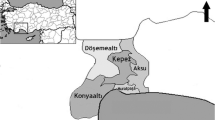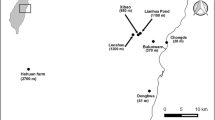Abstract
The present study aimed to identify ticks collected from road-killed wildlife species retrieved in several localities of southern Italy and to assess the presence of Borrelia burgdorferi sensu lato, Anaplasma phagocytophilum and Rickettsia spp. DNA in ticks. Collections were carried out from January 2000 to December 2009 on wild animals found dead within the territories of 11 municipalities from three regions (i.e., Apulia, Basilicata, and Calabria). In total, 189 carcasses of wild animals belonging to 10 species were checked for tick infestation, and 40 animals belonging to seven species were found parasitized. One hundred and twenty-five ixodid ticks (11 larvae, 14 nymphs, 77 males, and 23 females) were collected and identified as belonging to nine species, namely Dermacentor marginatus, Haemaphysalis erinacei, Hyalomma marginatum, Ixodes acuminatus, Ixodes canisuga, Ixodes hexagonus, Ixodes ricinus, Rhipicephalus bursa, and Rhipicephalus turanicus. None of the 36 tick specimens tested by PCR was positive for tick-borne pathogens. The results add new information on the tick fauna associated with wild animals in Italy, reporting new tick-host associations. Further field studies are still needed to ascertain the suitability of certain wildlife species as hosts for some tick species, particularly for those implicated in the transmission of pathogens to domestic animals and humans. Finally, from a conservation perspective, it would be interesting to assess whether these wild animals (e.g., Lepus corsicanus) are exposed to tick-borne pathogens, investigating the possible implications for their health and behavior.
Similar content being viewed by others
References
Beichel E, Petney TN, Hassler D, Brückner M, Maiwald M (1996) Tick infestation patterns and prevalence of Borrelia burgdorferi in ticks collected at a veterinary clinic in Germany. Vet Parasitol 65:147–155
Bengis RG, Leighton FA, Fischer JR, Artois M, Mörner T, Tate CM (2004) The role of wildlife in emerging and re-emerging zoonoses. Rev Sci Tech Off Int Epiz 23:497–511
Cancrini G, Calderini P, Gabrielli S, Scaramozzino P, Iori A (2007) Babesiosis and theileriosis: first evidence in domestic and wild animals in Lazio region (Central Italy). Parassitologia 49:80
Carpi G, Cagnacci F, Neteler M, Rizzoli A (2008) Tick infestation on roe deer in relation to geographic and remotely sensed climatic variables in a tick-borne encephalitis endemic area. Epidemiol Infect 136:1416–1424
Comstedt P, Bergström S, Olsen B, Garpmo U, Marjavaara L, Mejlon H, Barbour AG, Bunikis J (2006) Migratory passerine birds as reservoirs of Lyme borreliosis in Europe. Emerg Infect Dis 12:1087–1095
Courtney JW, Kostelnik LM, Zeidner N, Massung RF (2004) Multiplex real-time PCR for detection of Anaplasma phagocytophilum and Borrelia burgdorferi. J Clin Microbiol 42:3164–3168
Curioni V, Cerquetella S, Scuppa P, Pasqualini L, Beninati T, Favia G (2004) Lyme disease and babesiosis: preliminary findings on the transmission risk in highly frequented areas of the Monti Sibillini National Park (Central Italy). Vector Borne Zoonotic Dis 4:214–220
Dantas-Torres F, Figueredo LA, Otranto D (2009) A noteworthy record of Ixodes canisuga on Vulpes vulpes in the Apulia region, southern Italy. Parassitologia 51:109–111
Dantas-Torres F, Testini G, DiGeronimo PM, Lorusso V, Mallia E, Otranto D (2011) Ticks infesting the endangered Italian hare (Lepus corsicanus) and their habitat in an ecological park in southern Italy. Exp Appl Acarol 53:95–102
Daszak P, Cunningham AA, Hyatt AD (2000) Emerging infectious diseases of wildlife: threats to biodiversity and human health. Science 287:443–449
de la Fuente J, Estrada-Peña A, Venzal JM, Tocan KM, Sonenshine DE (2008) Overview: ticks as vectors of pathogens that cause disease in humans and animals. Front Biosci 1:6938–6946
Genchi C, Manfredi MT (1999) Tick species infesting ruminants in Italy: ecological and bio-climatic factors affecting the different regional distribution. Parassitologia 41(Suppl 1):41–45
Gern L (2008) Borrelia burgdorferi sensu lato, the agent of lyme borreliosis: life in the wilds. Parasite 15:244–247
Gray JS, Murphy TM, Waldrup KA, Wagner GG, Blewett DA, Harrington R (1991) Comparative studies of Babesia spp. from white-tailed and sika deer. J Wildl Dis 27:86–91
Gyuranecz M, Rigó K, Dán A, Földvári G, Makrai L, Dénes B, Fodor L, Majoros G, Tirják L, Erdélyi K (2010) Investigation of the ecology of Francisella tularensis during an inter-epizootic period. Vector Borne Zoonotic Dis (in press)
Hoogstraal H (1979) The epidemiology of tick-borne Crimean-Congo hemorrhagic fever in Asia, Europe, and Africa. J Med Entomol 15:307–417
Hoogstraal H, Aeschlimann A (1982) Tick host specificity. Bulletin de la Société Entomologique Suisse 55:5–32
Humair PF (2002) Birds and Borrelia. Int J Med Microbiol 291(Suppl 33):70–74
Iori A, Di Giulio A, De Felici S (2006) Zecche d’Italia. Mappe Parassitologiche. Rolando Editore, Italy
Iori A, Gabrielli S, Calderini P, Moretti A, Pietrobelli M, Tampieri MP, Galuppi R, Cancrini G (2010) Tick reservoirs for piroplasms in central and northern Italy. Vet Parasitol 170:291–296
IUCN (2010) IUCN Red list of threatened species. Version 2010.4. Accessed at: http://www.iucnredlist.org. Accessed 13 Jan. 2011
Jongejan F, Uilenberg G (2004) The global importance of ticks. Parasitology 129(Suppl):S3–S14
Juricová Z, Hubálek Z (2009) Serologic survey of the wild boar (Sus scrofa) for Borrelia burgdorferi sensu lato. Vector Borne Zoonotic Dis 9:479–482
Labruna MB, Whitworth T, Horta MC, Bouyer DH, McBride JW, Pinter A, Popov V, Gennari SM, Walker DH (2004) Rickettsia species infecting Amblyomma cooperi ticks from an area in the state of São Paulo, Brazil where Brazilian spotted fever is endemic. J Clin Microbiol 42:90–98
Liebisch A, Walter G (1986) Ticks of domestic and wild animals in Germany: on the occurrence and biology of the hedgehog tick (Ixodes hexagonus) and the fox tick (Ixodes canisuga). Dtsch Tierarztl Wochenschr 93:447–450
Manilla G (1998) Fauna d’Italia. Acari-Ixodida, Edizioni Calderini, Bologna
Matuschka FR, Fischer P, Heiler M, Richter D, Spielman A (1992) Capacity of European animals as reservoir hosts for the Lyme disease spirochete. J Infect Dis 165:479–483
Matuschka FR, Endepols S, Richter D, Ohlenbusch A, Eiffert H, Spielman A (1996) Risk of urban Lyme disease enhanced by the presence of rats. J Infect Dis 174:1108–1111
Millán J, Ruiz-Fons F, Márquez FJ, Viota M, López-Bao JV, Paz Martín-Mateo M (2007) Ectoparasites of the endangered Iberian lynx Lynx pardinus and sympatric wild and domestic carnivores in Spain. Med Vet Entomol 21:248–254
Oorebeek M, Kleindorfer S (2008) Climate or host availability: what determines the seasonal abundance of ticks? Parasitol Res 103:871–875
Otranto D, Lia RP, Cantacessi C, Brianti E, Traversa D, Giannetto S (2007) Filaria martis Gmelin 1790 (Spirurida, Filariidae) affecting beech marten (Martes faina): morphological description and molecular characterisation of the cytochrome oxidase c subunit I. Parasitol Res 101:877–883
Pfäffle M, Petney T, Elgas M, Skuballa J, Taraschewski H (2009) Tick-induced blood loss leads to regenerative anaemia in the European hedgehog (Erinaceus europaeus). Parasitology 136:443–452
Rehácek J, Urvölgyi J, Kocianová E, Sekeyová Z, Vavreková M, Kovácová E (1991) Extensive examination of different tick species for infestation with Coxiella burnetii in Slovakia. Eur J Epidemiol 7:299–303
Rizzoli A, Rosà R, Mantelli B, Pecchioli E, Hauffe H, Tagliapietra V, Beninati T, Neteler M, Genchi C (2004) Ixodes ricinus, transmitted diseases and reservoirs. Parassitologia 46:119–122
Rosalino LM, Rodrigues M, Santos-Silva M, Santos-Reis M (2007) Unusual findings on host-tick interactions through carnivore scat analysis. Exp Appl Acarol 43:293–302
Rundel PW, Montenegro G, Jaksic FM (1998) Landscape disturbance and biodiversity in mediterranean-type ecosystems. Series: ecological studies, 136. Springer, Berlin, p 447
Schex S, Dobler G, Riehm J, Ller JX, Essbauer S (2011) Rickettsia spp. in wild small mammals in lower Bavaria, South-Eastern Germany. Vector Borne Zoonotic Dis (in press)
Stefanidesova K, Kocianova E, Boldis V, Kostanova Z, Kanka P, Nemethova D, Spitalska E (2007) Evidence of Anaplasma phagocytophilum and Rickettsia helvetica infection in free-ranging ungulates in central Slovakia. Eur J Wildl Res 54:519–524
Tälleklint L, Jaenson TG (1993) Maintenance by hares of European Borrelia burgdorferi in ecosystems without rodents. J Med Entomol 30:273–276
Tampieri MP, Galuppi R, Bonoli C, Cancrini G, Moretti A, Pietrobelli M (2008) Wild ungulates as Babesia hosts in northern and central Italy. Vector Borne Zoonotic Dis 8:667–674
Walker JB, Keirans JE, Horak IG (2000) The genus Rhipicephalus (Acari, Ixodidae): A guide to the brown ticks of the world. Cambridge University Press, Cambridge
Author information
Authors and Affiliations
Corresponding author
Rights and permissions
About this article
Cite this article
Lorusso, V., Lia, R.P., Dantas-Torres, F. et al. Ixodid ticks of road-killed wildlife species in southern Italy: new tick-host associations and locality records. Exp Appl Acarol 55, 293–300 (2011). https://doi.org/10.1007/s10493-011-9470-4
Received:
Accepted:
Published:
Issue Date:
DOI: https://doi.org/10.1007/s10493-011-9470-4




